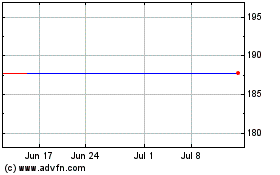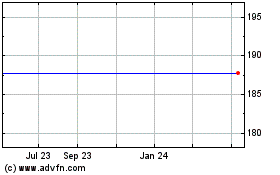Micro Focus's HP Software Purchase Puts It in the Big League
September 08 2016 - 6:10AM
Dow Jones News
LONDON—Micro Focus International PLC's $8.8 billion plan to
purchase Hewlett Packard Enterprise Co.'s software business will
triple its workforce and sales and lifts the little-known British
firm into the big leagues of European tech companies.
It also throws a spotlight on an obscure corner of the tech
world. Micro Focus, founded in 1976, helps companies with
long-established computer infrastructure update their information
technology without having to replace their old systems. In one
recent project, it helped Scandinavian Airlines parent SAS AB
modernize its business-analysis capabilities.
Micro Focus's competitors include big software companies such as
International Business Machines Corp. and Microsoft Corp., as well
as more specialized operators such as Red Hat Inc. After the HP
Enterprise deal, Micro Focus will have combined annual revenue of
$4.5 billion, up from $1.2 billion currently, making it one of the
world's largest pure-play infrastructure-software companies, it
said.
Although the acquirer in a multibillion-dollar deal usually
trades lower on the news, Micro Focus bucked that trend. Its shares
jumped as much as 22.8% in morning London trading, giving it a
market capitalization of around £ 5.5 billion ($7.3 billion),
though it later surrendered some of those gains.
Micro Focus, based in Newbury, England, employs 4,300 people
around the world. The deal will triple that staff, said Micro Focus
Chief Executive Kevin Loosemore in a call with journalists.
The deal originated when Mr. Loosemore contacted HP Enterprise
around February, following the company's separation from HP Inc.
last year, to find out what its postsplit strategy would be, he
said.
The fall of the pound against the dollar after the U.K.'s June
23 vote to leave the European Union had "no real effect" on the
deal, Mr. Loosemore said. The currency move boosted the value of
Micro Focus's shares, but also made the cash portion of the
dollar-denominated deal more expensive.
The Micro Focus deal is a rare example of a U.K. tech company
making a big overseas acquisition. It is also a sort of homecoming
for a chunk of the HP software business.
The Micro Focus acquisition involves the company taking over
some of the assets that HP acquired when it bought U.K.
data-software company Autonomy for $11.7 billion in 2011. Autonomy,
which was run by co-founder Michael Lynch, was one of Britain's
highest-flying tech firms before its purchase. After the deal,
however, HP alleged fraud and wrote down a big chunk of the value
of the deal. Mr. Lynch, who denies the fraud allegations, is
fighting HP in court.
The size and profile of the HP deal contrast with Micro Focus's
status as one of a number of largely unremarkable U.K.-listed
business-software providers.
The deal also represents the latest sign of progress for the
company, which only five years ago posted a string of profit
warnings, prompting a management shake-up and speculation that it
could itself be subject to a takeover. Media reports at the time
even suggested Hewlett Packard could be interested.
More recently, the company has regained its footing and moved to
acquire several companies, including Houston-based peer Attachmate
Group for $1.2 billion in 2014.
Micro Focus's status as one of the U.K. biggest listed
technology companies was recently confirmed with news it would be
promoted to the U.K.'s blue-chip FTSE 100 index to replace ARM
Holdings PLC, which Japan's SoftBank Group Corp. recently
acquired.
Micro Focus was founded by Brian Reynolds and Paul O' Grady in
1976 as a small operation in Notting Hill, London specialising in
COBOL, a software language that was developed in the 1950s.
Peter Stiff contributed to this article.
Write to Rory Gallivan at rory.gallivan@wsj.com
(END) Dow Jones Newswires
September 08, 2016 05:55 ET (09:55 GMT)
Copyright (c) 2016 Dow Jones & Company, Inc.
Red Hat (NYSE:RHT)
Historical Stock Chart
From Mar 2024 to Apr 2024

Red Hat (NYSE:RHT)
Historical Stock Chart
From Apr 2023 to Apr 2024
